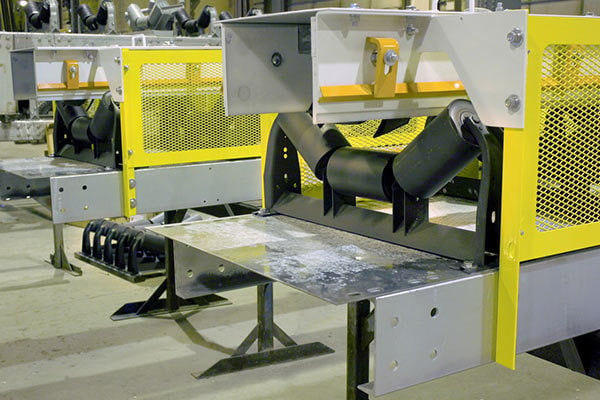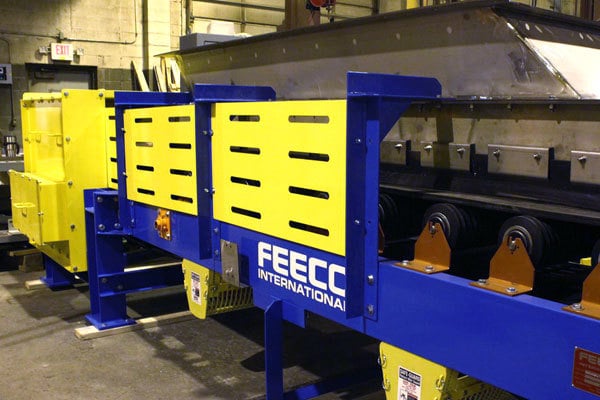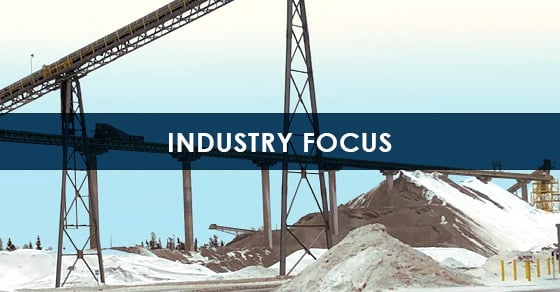Troughed belt conveyors are used prolifically throughout the mining industry, carrying ores, concentrates, and tailings throughout every stage of the mining cycle, from initial excavation, through beneficiation, to the production of a refined material ready for market, and each step in between.
Belt conveyors are customized and combined in an endless array of configurations, making each handling system as unique as the material it carries. The diverse configurability of belt conveyors has made them essential in feeding process operations, transporting material to storage, and navigating material through load-out. They have the capability to automate otherwise-arduous tasks, reduce labor requirements and human-material interaction, and effortlessly maneuver through difficult terrain and spatial restrictions.
The growing demand for raw materials, combined with a continued emphasis on improving efficiency will only increase the need for these flexible bulk handling systems as time goes on. And while the design of these machines is highly site and material specific, there are two requirements that the mining industry always demands of their belt conveyors: safety and reliability.
Safety
Safety practices have come a long way since the canary-in-the-coal-mine days. Today, safety is heavily regulated in every aspect imaginable. In the United States, the Department of Labor’s Mine Safety and Health Administration, or MSHA, oversees safety compliance at mine sites across the nation. This includes the regulation of belt conveyors, and most notably, conveyor guards.
Troughed Belt Conveyor Guarding
Although conveyors decrease the amount of manual transport required, thereby improving worker safety, they are still made up of moving parts and subsequently carry inherent risk.
Guards are the primary line of defense in protecting workers from the moving parts of a belt conveyor and are a standard feature on conveyors in any industry. The increased potential for danger at mine sites, however, requires a higher level of guarding, as mandated by MSHA. According to the group, equipment guarding is the most frequently cited violation at mine sites, representing substantial risk.
While guarding requirements are based on a number of factors, conveyor components that typically require guarding at mines include:
- Head and tail pulleys
- Take-up and bend pulleys
- Return idlers
- Drive or power assembly components
- Skirtboard areas
- Sides of the conveyor
- Top side of conveyor between end of tail pulley and end plate skirtboard
- Gravity Take-up Assembly (Safety cages are included at the base (at grade) of the gravity take-up assembly (GTU). Where applicable, additional guards must be added at every floor level where the GTU system is accessible.)

Troughed belt conveyor with side guards in fabrication
Guarding is a critical factor in maintaining a safe working environment and reducing the potential for injury. For this reason, safety should be a top priority in the conveyor design process.
In addition to the guarding required by MSHA, FEECO standard guarding is designed to cover all rotating shafts in the drive area in order to further reduce the risk of injury. FEECO also often implements closed-end housing bearings where the shaft is not required to extend beyond the bearing as an added safety precaution.
Similarly, FEECO return idler guards are designed to not only protect employees from nip points, but also to act as a catch basket for the return idler in the event of idler failure, preventing the idler from falling on employees.
Reliability
Apart from safety, the most important aspect of troughed belt conveyors in mining is that they are reliable. Conveyors at mine sites are typically working with large capacities of material under tight deadlines and harsh conditions. Low-quality, or off-the-shelf equipment simply cannot meet these demands; conveyors intended for mining must be engineered to minimize downtime and operate reliably long-term, despite tough conditions.
Designing Troughed Belt Conveyors for Mining Applications
When it comes to designing conveyors, the components and materials of construction are what differentiates a sub-par conveyor from one capable of meeting the demands of the mining industry.
In terms of design, this translates to rugged materials of construction, reinforced loading areas, wear liners for added protection when needed, and heavy-duty components. Typical areas and components that see an upgrade for mine-duty applications include:
Materials of Construction
Belt conveyors intended for mining often require more durable materials of construction. This might include utilizing heavier-construction belting, larger diameter idler rolls and bearings, higher service factors for drive selection, or galvanizing frames to protect against the elements. Similarly, depending on the material, alloys and special cover compounds may be employed to defend against corrosion or other concerns.
Pulleys & Idlers
Depending on the application, pulleys are typically either mine-duty or heavy-duty. Idlers are typically CEMA D or CEMA E.
Skirtboards
Skirtboards are made from heavier materials, with wear liners added when necessary. Impact tables are often used at load zones, with skirt sealing systems along the remainder of the skirts in order to prevent spillage.
Drive Assemblies
Drives may require a soft-start package or fluid couplings to aid in starting a conveyor under full load, which happens often at mine sites. Heavy-duty motors and gear reducers are also frequently employed to accommodate the demanding loads so characteristic of the industry.
Wear Liners
In addition to selecting the appropriate materials of construction, wear liners are also commonly added to conveyors for mining applications. Wear liners are available in a variety of materials to suit the needs of the specific application. Common materials for wear liners include UHMW, Tivar, Stainless Steel, Abrasion-Resistant plates, and more.
Dust Suppression
When dust is a concern, a dual sealing-type skirt rubber (apron seal) can be employed to minimize dusting at load points. Dust pick-off points for managing fugitive dust at transfer points may also be necessary in some cases.
Customizations
Belt conveyors and material handling systems vary significantly from site to site, even when handling the same material. Material characteristics, facility layout, topography, and more, will influence design parameters for the handling system and every conveyor in it. In addition to the customizations listed above, other commonly requested components in the mining industry include:
- Added support structures
- Channel or truss frames
- Weather covers and gallery enclosures
- Service platforms and walkways
- Belt cleaners
- Safety cables and shut-offs
- Belt scales
- Automation
- Cleated, chevron, heat-resistant, and other specialty belt types
Equipment to increase the functionality of troughed belt conveyors, such as belt feeders, trippers, or plows, may also be helpful.

The belt feeder under construction in the photo above is destined for use at a mining facility. Guarding can be seen around the take-up assembly and along the side of the conveyor at the skirtboard load zone (some guards were removed for the purpose of this photo).
Conclusion
When it comes to bulk material handling, the needs of the mining industry are perhaps the most demanding of any industry, necessitating a conveyor manufacturer familiar with the rigorous nature of the work.
In selecting a mine-duty belt conveyor manufacturer, ensure that the manufacturer is not only familiar with and capable of manufacturing conveyors and guards that are compliant with MSHA standards, but also that they have a proven track record of success in the industry; in order to provide reliable, long-term performance, conveyors must be constructed out of heavy-duty materials and durable components.
FEECO belt conveyors, bucket elevators, and other bulk material handling equipment are relied upon by the mining industry day in and day out. With quality specifications that go beyond the norm, FEECO conveyors provide a custom handling system optimized for the unique challenges of the project. Our Customer Service Team also provides a range of parts and services to keep material handling equipment running its best, whether it was built by FEECO or not. For more information on our custom conveyors, contact us today!



